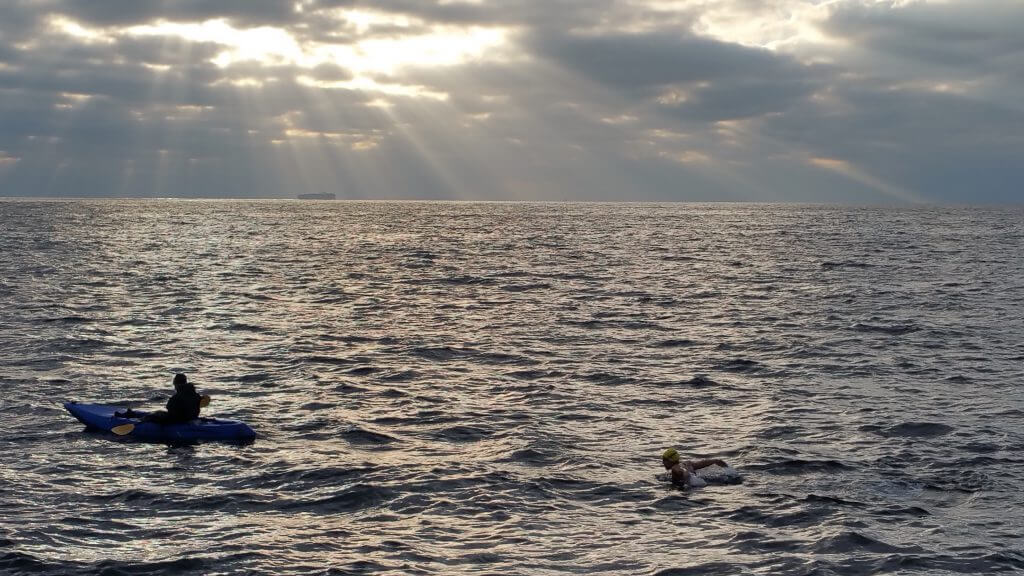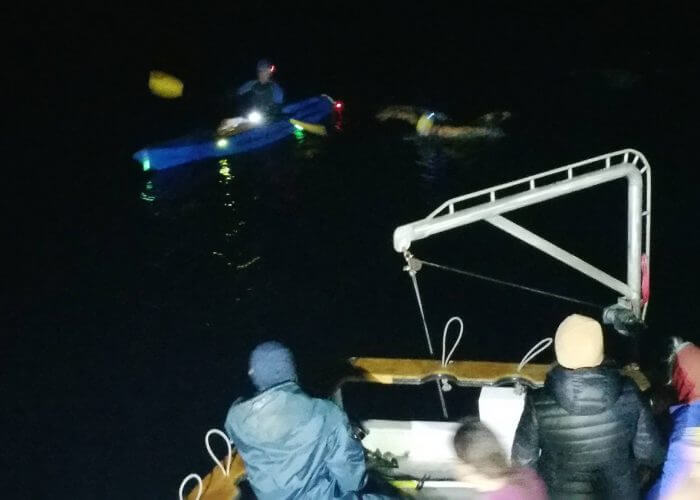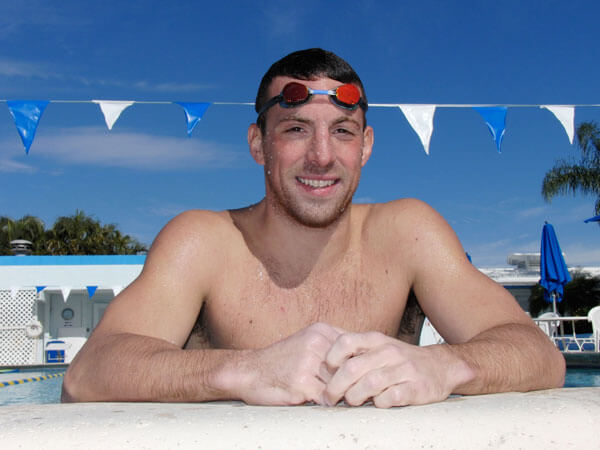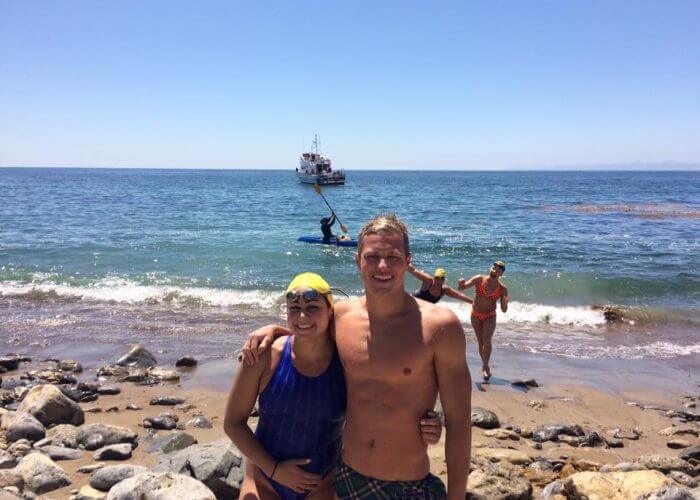Thoughts While Swimming 20.2 Miles of Butterfly

By Melissa Berkay, Swimming World College Intern
“There are stars in the water!” my grandmother said, staring down at the pitch black water from the front of the boat. Bioluminescent phytoplankton glistened in the calm waves as the boat cut its way through the water; when touched, the plankton would light up like stars, and the clusters that gathered at the touch of the boat broke apart and left a trail behind it. I was seeing this happen in the cups of my hands as I swam through the salty water.
The escort boat was 10 feet to my left and my kayaker was three feet to my right. Exhaust fumes were filling my lungs, and my kayaker and I were adjusting our placement in relation to the boat to attempt to limit the amount of fumes entering my lungs. I had just begun my 20+ mile journey to cross the Catalina Channel. It was around 11:08 p.m.
My stroke rate was quick, my arms and legs felt strong, and I began the swim on a good note as I developed a steady rhythm in my stroke. Endlessly counting to 100 in my head while swimming was my strategy at the beginning, and something I had practiced during my long 8 to 10 hour training swims I had done weeks before I set foot into the Catalina waters.
“You have to vomit! Your body is trying to regulate itself!” my kayaker Robin Hipolito shouted so I could hear him through my earplugs. Nausea overcame my entire being throughout the night, and I was swimming at a slow .8 miles per hour. Everything I ingested wanted to come back up, and I was fighting to keep it down, in fear that my crew would pull me out of the water for getting sick. I fought with my stomach for over six hours, and was confused as to what was causing me to experience intense internal pain while swimming.
I was stubborn about vomiting, fearing that the imbalance of my electrolytes would prevent me from continuing, and that I was going to lose strength. It was not until Robin told me what my body was trying to do that I realized I was doing myself more harm than good by fighting my nausea. I had stopped and asked my support swimmer, Tommy Anderson, to swim freestyle next to me for 60 minutes to motivate me.
I had prayed to God underwater to help me complete the swim. I had stopped and bawled due to the pain and cramping I was experiencing throughout my insides and limbs, and due to the fear I was experiencing from having complications during my swim. I thought I could go no further. I steadily swam faster and felt better after I puked. The Pedialyte I had bought before my swim was a life saver, and instead of eating almond butter as I had been doing throughout the night, I switched to consuming GU gels every half an hour. Coach Sara Nevin from Mills College stayed up through the night to observe my fuel intakes and to support the swim.
The vibrant spirit of the United States Olympic swim team kept my mind focused in the water while I was in the process of tapering for my own significant event– a 20.2-mile crossing of the Catalina Channel using only the butterfly stroke the entire length. I watched as many Olympic events as I could in the days leading up to the Catalina Channel, and watched Touch the Wall a couple times.
I was to be the first American to cross the Catalina Channel swimming the stroke of butterfly, and I used this marathon swim to fundraise for three non-profit organizations who aid the homeless and destitute of San Diego and San Francisco, California. Since I have trained and competed for most of my life in the pool, watching the Olympics motivated me to think of my Catalina Channel swim as simply another race.
When my crew and I first arrived at the island (after a 2.5 hour boat ride) Catalina Island looked like a shadow in the dark night, and my eyes squinted as I tried to see something on the land from the boat. “This is crazy! Is this real?” I said to my observer, Kelley Prebil, as she pointed out the island to me, and gave me pointers as to how to swim under the buoy line, exit the water on shore, follow all procedures to prevent disqualification, and how to start the swim properly.
I was terrified, confident, optimistic, excited, full of dread, doubtful, calm, and nervous all at the same time. I had been training and waiting for months to arrive at the island, visualizing how the swim would go, night after night, practice after practice, and the day was here to make those visualizations a reality.
Just like any race in the pool, I had done all I could to the best of my abilities to prepare for the swim. But 20 miles of butterfly is a drastically different event compared to the 200 butterfly or the 400 IM races. I calmed my nerves before the swim with a pre-race routine. Just as I would before any race in the pool, I prayed. I had prayed with my pastor before the swim, and this supplemented my preparation.
I had adjusted my cap, licked my goggles, molded my earplugs into my ears, was shaved and tapered for the swim, and had freshly painted nails for good luck. I had applied sunscreen to stave off intense UV rays I might face in seven hours when the sun came up. I used up a large-sized Vaseline tub to grease my suit lining and prevent chafing.
My captain gave me the clear to swim out to the shore, and I followed my kayaker to the shore of Catalina. I swam under the official buoy line the Catalina Channel Swimming Federation had placed for official swims to start, felt slimy seaweed clothe my body as the water became increasingly shallow, and I stepped on the harsh pebbles and rocks that would usually hurt my feet.
My adrenaline was sky-high, and I waited, wide-eyed, as the captain of my escort boat signaled to my kayaker that it was okay for me to go. My official observers were ready on the escort boat with their clipboards, to document every move and action I did during my swim, and my crew was attentively present on-deck during the start.

Photo Courtesy: Curtis Bernstein
Do you know that saying “the darkest hour occurs right before dawn”? This saying represents the experience I had during the night of my swim…
I was swimming through black water, the sky was dark, and my mind shifted back and forth between positive thoughts and dark thoughts. I thought it would be best to manage my thoughts in order to produce internal positive reinforcement. My body and mind were feeling ill, but I coached myself by saying “you can do this,” and I prayed to God saying “please help me get through this.” I forced myself to smile underwater because I had read in a Swimming World Magazine article once, that if you force yourself to smile at some point during a grueling swim practice, you could alter the chemicals in your brain to produce positive thoughts, and keep yourself going through the practice.
I remembered the positive people in my life; those I admired. Charlotte Samuels had given me advice a few weeks prior to the crossing. I had interviewed her for a piece I was writing, and after the interview, she told me some rules I was determined to remember:
1. Do not look back at the island while you are swimming.
2. Stay below deck on the boat ride to Catalina prior to the start of your swim to prevent viewing the distance you were just about to cross.
Despite complications during her crossing, she successfully made it. I thought “if she can hit that physical and mental wall, push through, and force herself to make it to the other side, I can too.”
I thought of my friends who had wished me luck via social media and let their positivity ripple for me. I thought of my Mills College family, who were following my GPS tracker throughout the night, and remembered how much they inspired me to believe in myself. I thought of my South End Rowing club team members who were cheering for me, and about how successful my fundraiser was becoming.
I thought of Lynne Cox, who I had watched on TedXTalks via YouTube, the day before. Her quote from the video “with each stroke my hands were reaching into the future, and pushing the past behind me,” resonated in my mind as I used it as encouragement to push forward.
I thought about Fran Crippen, my teammate while I was in high school and training with the Mission Viejo Nadadores, and how he would have been so proud and happy for me if he knew what I was doing. He would be happy to see how far I had come, how I never quit swimming, and how I found love in the water.

Photo Courtesy: Fran Crippen Elevation Foundation
These thoughts engulfed my mind, and gave me joy and hope. The positive thoughts I had in my mind were like the stars in the sky and the shining algae “stars” in the water– the lights in the darkness. There was a lighthouse in the distance, and the beaming yellow light would appear every few minutes. The bursts of light looked like fireworks and encouraged me to keep going.
During a long distance swim, one has to urinate every 30-60 minutes, and has to let their crew members know every time this was occurring, so they can ensure the swimmer’s kidneys are properly functioning. This was the most embarrassing part of my swim. I am not good at peeing while I swim, and I had to stop every time I forced myself to go, while my kayaker would should “she is peeing!” to the escort boat. My goggles were leaking. At daybreak, I switched to my smoky pair of goggles.
I had picked up my pace to 1.8 miles per hour that morning, and was making progress to the shore. My coach from Mills College, Neil Virtue, who had a BA in zoology, once said his spirit animal was a sloth. I felt very sloth-like as I progressed to the California mainland.
When one is swimming butterfly, you are constantly looking ahead– the land was there, I saw trees, I saw houses, I saw some water dividing us, but it was not getting any closer. The current picked up a bit in the morning, and it pushed me a little off course. I practiced patience and reminded myself that I was getting closer; I would finish.
Robert Palmese had taken off to do his triple-crossing attempt with the Outrider escort boat the same night I began my swim, and I wanted to pass them while I was doing my own crossing. Later, I found out that he had experienced a complication due to injury and had to abort the swim to prevent permanent injury.
Dan Simonelli was on Rob’s boat, and waited for me to land in Rancho Palos Verdes. Tommy got back into the water to swim butterfly with me into the shore. “I’ll race you the last 400 meters,” I told him. The sand was strange to my mind– my body was confused when I stepped out of the water. I screamed in excitement and discomfort while exiting the water due to physical and mental transition I had to make in order to walk. So I ran.
Dan gave me hugs, he took of photo of Tom and I, and it was not until I swam back to Pacific Star, my escort boat, that I realized what I had just done.
I did it! I worked through it! I had not let my non-profit organizations, family, friends, supporters, and donors down! Happily smiling, I rode back to the dock at San Pedro.
Postscript

Photo Courtesy: Dan Simonelli
I wanted my last summer submission to this publication to not be about my accomplishment, but about the learning, strategies, tools, and lessons involved in completing an athletic endeavor such as this. The same things that worked during my swim, can be applied to almost any goal in life.
Discipline, hard work, dedication, commitment, resilience, optimism, grit and many other qualities contributed to the positive outcomes in any goal or journey. I would like to use my crossing as an example of the will to not let obstacles, challenges, and unexpected complications get in the way of achieving a goal.
The crossing is just a small example of what the human mind and body are capable of. Many marathon swimmers have accomplished more than I have, and have pushed the limits of what we thought possible. When explaining my summer goals, one of my close family members said “You cannot do this. Who do you think you are? This is crazy and impossible,” and at the time of the comment, it seemed harsh, but I quickly learned how to use negativity as fuel.
This swim renewed my faith. It taught me that if anyone puts in the work, their dreams can and will come true.




Amazing!
+1 for Amazing, really incredible accomplishment – thanks so much for your article.
Psh!! Great Job Melissa, you totally deserve it!
Great Job Melissa, you totally deserve it!
OMG!!!! AMAZING ACCOMPLISHMET!!!!! F A N T A S T I C A R T I C L E ! ! ! ! ! ! ! B R A V A A A A A A A A A A A M E L I S S A A A A A A A A A A ! ! ! ! ! ! ! !